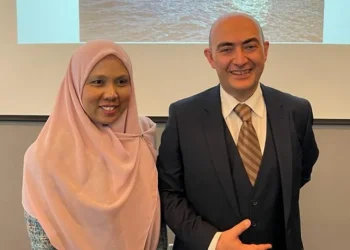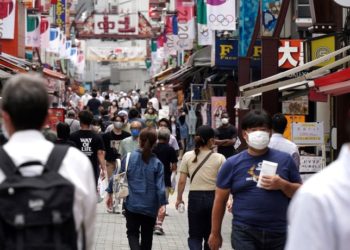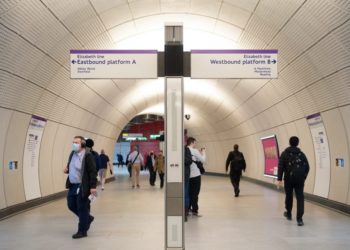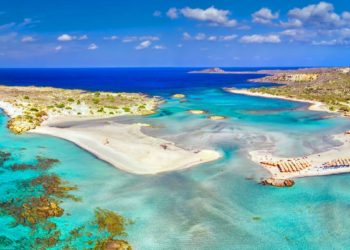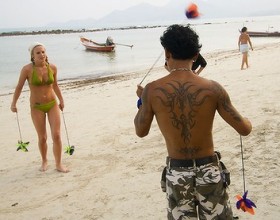 James Shrimpton finds that Thailand’s popular island isn’t just for young fans of The Beach.
James Shrimpton finds that Thailand’s popular island isn’t just for young fans of The Beach.
Shattering the calm of a warm afternoon in the Samui township of Lamai, two vans prowl the streets with loudpeakers espousing the delights of two beach parties organised by the rival Ark and Reggae clubs, promising music and fun lasting until 2am.
It’s a reminder that while Koh Samui in recent years has climbed to the top end of Thailand’s tourism market, it still caters to the backpackers and budget travellers who in the 1970s first “discovered” the then-undeveloped island, on the Gulf of Thailand 700km south of Bangkok.
Non-fancy accommodation is still available around Samui from around 400 baht ($A14) a night, but on and around the cliffs overlooking the sea is now a growing warren of resorts with matchless views, five-star furnishings, exquisite cuisines and infinity swimming pools – at umpteen times the cost.
And these deluxe havens of privacy are attracting more and more attention from the ranks of the rich and famous.
American singer Britney Spears was reported staying at one of the newer resorts during our recent visit, and we were told that British soccer star David Beckham has invested in a million-dollar villa here.
We took a look at half-a-dozen of them and stayed a couple of nights at two: the Baan Taling Ngam Resort and Spa (70 villas, suites and rooms) on an old coconut plantation on the west or so-called Virgin Coast, and the Silavadee Pool Spa Resort (55 villas, suites and rooms) near Lemai in the southeast.
Both have spacious reception areas atop cliffs 110m or so above the Gulf, and both use golf carts to ferry guests from their tiered rooms to the white-sand beaches below, from which boats can take them on excursions to small offshore islands for exploration, swimming and snorkelling.
The immaculately-furnished guest rooms all have stunning sea views, as do diners in the outdoors/indoors restaurants.
Samui itself is Thailand’s third largest island with an area of 228.7 square kilometres, roughly the same shape as Tasmania but about 300 times smaller.
Weather is tropically warm all year, with an average high of 30 degrees Celsius; September and October are the rainy months.
Tourism has become the number-one industry on Koh Sumai.
First settled some 1500 years ago by fishermen from the Malay peninsula, the island was known as a grower and exporter of Kapok cotton and coconut products before the backpackers began arriving 25 years ago.
A trickle soon became a stream as mostly young persons from Britain and elsewhere came to enjoy cheap holidays in the sun – not totally unlike (at least geographically) the island of Phi Phi Le featured in the Leonardo DiCaprio movie The Beach, released in 2000.
The stream became a flood in the 1990s as the choice of resorts grew, enjoyed by holidaymakers of all ages from Europe, Australia,in Asia and North America.
Around the most popular beach areas grew the townships of Chaweng, Lemai, Taling Ngam and the capital, Nathon.
They now bustle with customers of the many 7/11 mini-supermarkets, ready-in-two-days tailors, clothing and souvenir shops, restaurants, Thai massage houses, banks and travel companies, plus a couple of smart shopping malls.
The island’s airport, which itself looks more like a tropical resort, opened in 1989 and ending reliance on ferries from the mainland; it was upgraded in 2004-05 to allow for up to three million passengers a year.
“Koh Samui grew up, and so did tourism here,” says general manager Nigel Tovey of the Baan Taling Gnam resort, which underwent multi-million-baht upgrades last year.
Among attractions were “hundreds of untouched beaches and high-quality resorts with great food prepared by top-class international chefs,” he added, rating Koh Samui in this respect, at least the equal of the much larger island of Phuket.
Most hotels have gyms for exercise as well as spas, for speciality Thai and other massages.
The island also offers a variety of other sports along with the boat trips, snorkelling and diving, elephant rides, jungle treks and shows with monkeys collecting coconuts from tall palms, throwing them to the ground where tourists can drink their refreshing milk.
Jet skis can be hired from Chaweng, the largest and most popular beach, and from Lamai; speedboats and sailboats are also available elsewhere as are parasailing, kite-flying, volleyball and fishing.
Away from the beach you can drive quad bikes through the jungle, fire AK-47s at a shooting range – and play golf on three courses, one of 18 holes and two of nine.
The 18-holer, the par-72 Santiburu Samui Country Club south of Mae Nam on the north coast, and the grandly-named Royal Samui Golf and Country Club, with (so far) nine holes behind the mid-east coast and a par of 33, are hilly and challenging but also present the player with awesome views of beaches, the Gulf and its islets.
Another nine holes are planned for the “royal” but construction has been delayed due to financial difficulties.
The other course, the Bophut Hills Golf Club in the northeast, is flatter and not so physically taxing, with nine par-three holes.
During our stay we also viewed and dined at these other resorts:
. Bandara Resort and Spa Samui – one of the largest, with a total of 150 rooms, suites and penthouses in a garden setting, on Bophut Beach in Samui’s north.
. Melati Beach Resort & Spa – a total of 77 luxurious villas, suites and rooms on the beachfront at Thongson Bay, near the island’s northernmost tip.
. Pavilion Samui Resort & Spa – a beachfront boutique resort in tropical gardens in downtown Lemai, offering 70 suites and rooms.
. The Kala Samui – another clifftop resort, with eight villas and 30 rooms set amid natural vegetation and rock formations, with great sea views; kala is the Thai word for coconut shell, and the table settings for lunch were all coconut-based, from mats to decorations.
. Anantara Koh Samui Resort and Spa – one of the prestigious Anantara chain of resorts specialising in massage and other spa wellness treatments, located on Bophut Bay.










